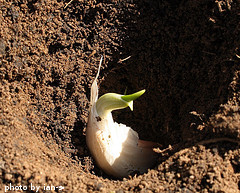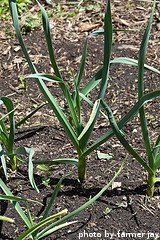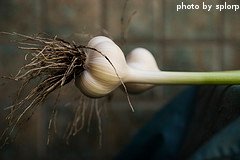Curious About Fertilizing and Watering Garlic?
You've come to the right place. Watering garlic can be an important part of growing a successful garlic crop. If there's not enough moisture in the soil, the plant has trouble absorbing vital nutrients. On the other hand, if there's plenty of moisture but not enough naturally occurring nutrients, you'll need to fertilize your garlic patch. You go through a fair bit of trouble and expense to prepare your garden plot and plant the seed cloves. The last thing you want is to waste that time and money by not giving the plants what they need to successfully grow. Fertilizing and watering garlic is a huge part of that process.
Watering Garlic

The key to successfully watering garlic is making sure that the soil drains well. If your garlic sits in waterlogged soil for very long, it will begin to rot. Garlic needs relatively small amounts of water. No watering is necessary in the winter months when garlic is covered with mulch. If you experience little rainfall in the spring, you can water your garlic crop every couple of weeks. A light watering down to a depth of 1 inch should be sufficient. If you get reasonable rainfall every 10-14 days, watering is usually not needed. Once it begins to sprout, you can begin watering garlic with longer and deeper soaks down to a soil depth of 2-3 inches. If it has not been unseasonably dry in your area, it's usually better to water too little rather than too much.
The best way to check the moisture level in your garlic patch is to use your fingers and dig down about 4 inches into the soil next to the plants. Grab a handful of dirt and squeeze it in your palm. You want the dirt at this depth to be moist, but not soggy. You want it to hold together for a couple of seconds when you squeeze it, before it falls apart. If it's too wet and doesn't fall apart at all when you squeeze it, let it dry out for a few days and check again. If the soil is really dry and doesn't hold together at all when squeezed, you should go ahead and water your garlic plants.
In our own garden, we typically water our garlic patch with an overhead oscillating sprinkler. We turn it on and let it run for about 20 minutes or so if we don't get any rain for 10 days or so. With garlic, we aren't worried too much about the foliage staying wet because there aren't too many diseases or fungal infections to worry about when growing garlic.

Fertilizing Garlic
After you pull back the mulch in the spring and the temperatures are moderate, a light application of an all purpose fertilizer can be applied every 30-40 days. Look for 5-5-5 or 10-10-10 fertilizer. These three numbers indicate the amount of nitrogen, phosphate and potassium that are contained
in that particular fertilizer, respectively. For instance, a 10-10-10 fertilizer contains 10% nitrogen, 10% phosphate and 10% potassium. A 5-10-10 bag would contain 5% nitrogen, 10% phosphate and 10% potassium. Use your hands and sprinkle the fertilizer granules on the ground around the emerging garlic, making sure that the granules do NOT come in contact with the plants themselves. This may burn the plants or have other
negative consequences. Follow the manufacturer's directions for the amount of fertilizer to apply and divide that number by half. Most fertilizers are applied at a rate of 1 1/2 pounds per 100 square feet. Therefore, you should apply at a rate of 3/4 of a pound per 100 square feet. Try to apply the granular fertilizer a day or two before rain is expected. The rain will help the fertilizer to penetrate the soil.
In our own garden, we typically fertilize our garlic patch twice - once when we plant and again in the spring when the plants are a few inches tall.
Before we plant, we till the soil really well. We then scatter a balanced granular fertilizer at a rate of 1 pint per 200 square feet. We also scatter pulverized lime because our garden soil is a bit acidic and lacks calcium. We then till these additives in and then water the area really well so that the additives start to break down. We then wait a week or so before tilling one last time and building our raised rows. We typically apply a second dose of fertilizer in early May, when the plants are a few inches tall. We scatter the same balanced fertilizer along the edges of the raised rows at the same rate of 1 pint per 200 square feet. We are especially careful to not let the granules come in contact with the plants.
Once the leaves of the garlic stalks have died back to a certain point, it's time to harvest.

Click here to learn about harvesting garlic
Click here for some garlic recipe ideas
Click here to move from our Watering Garlic page to the Growing Garlic main page
Click here to return to our Home page